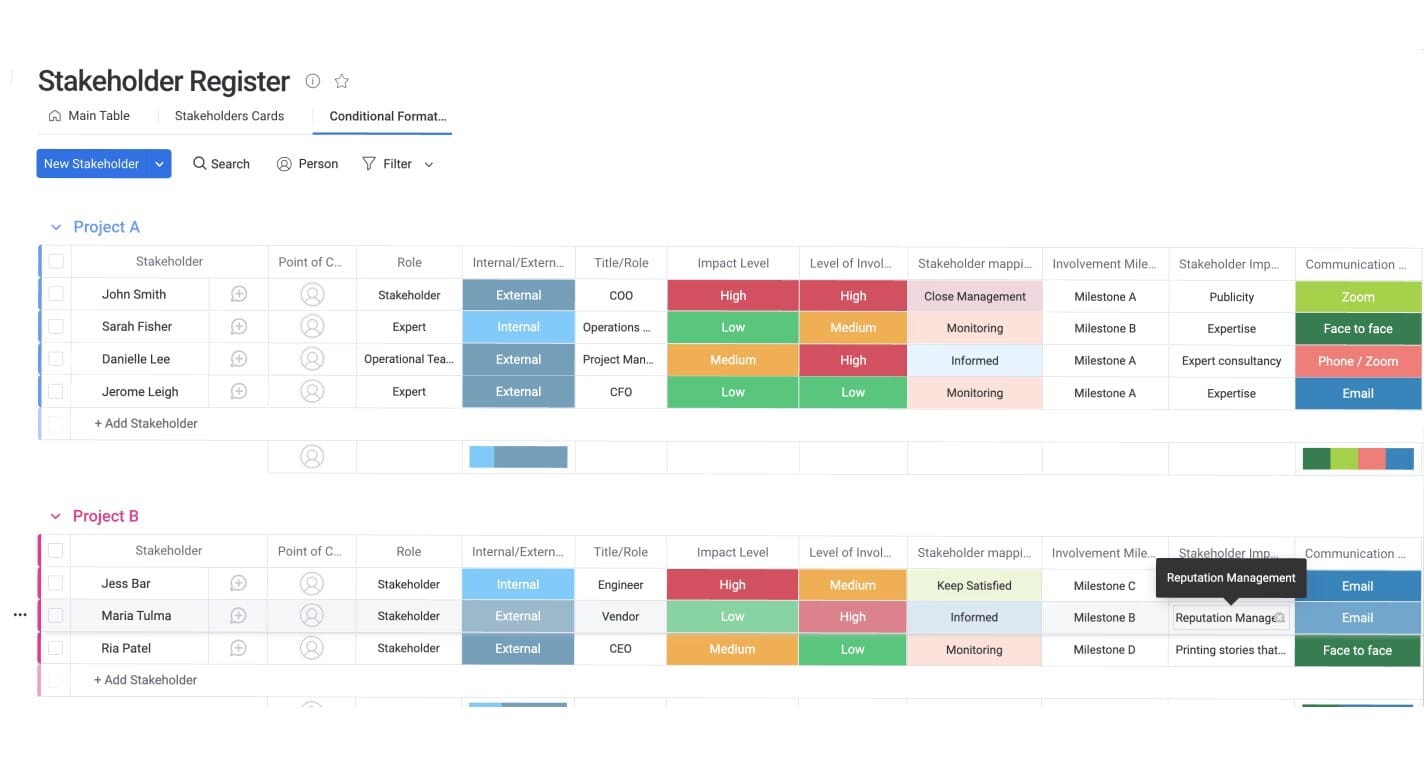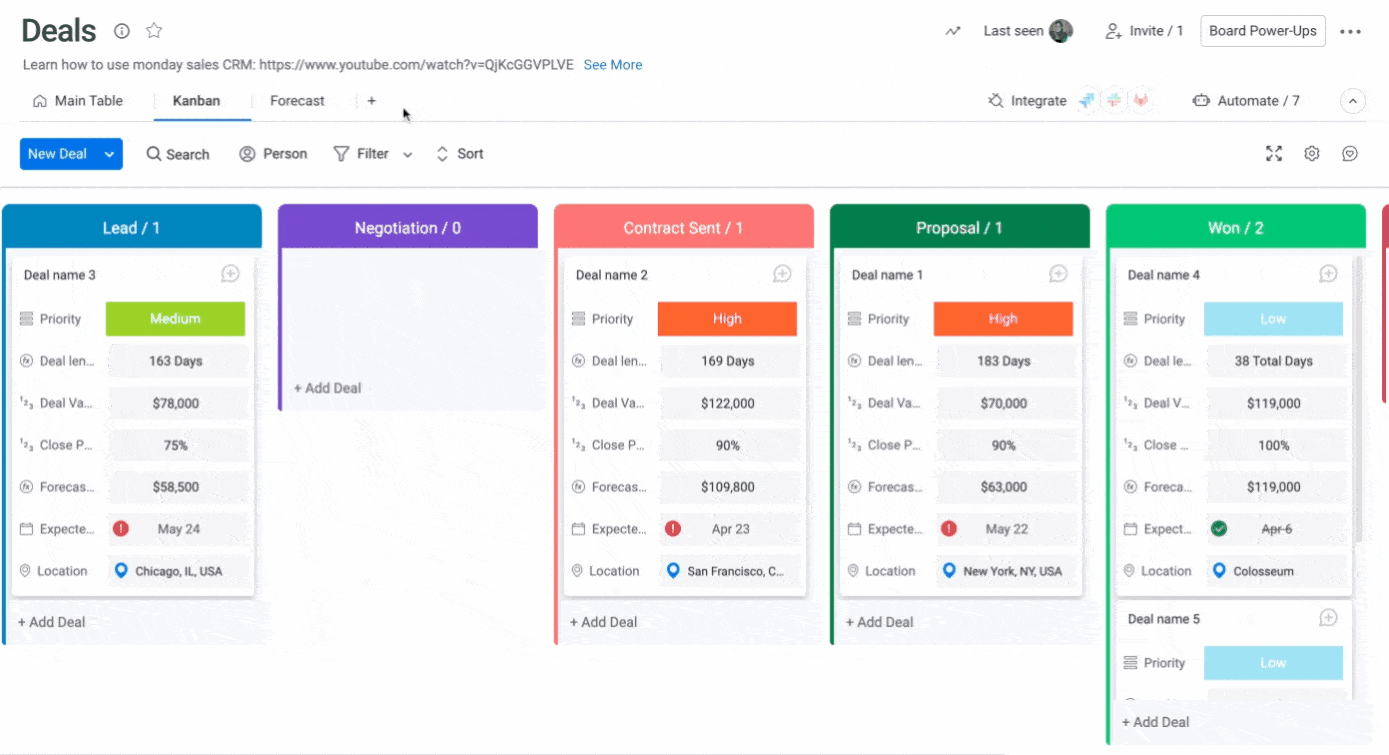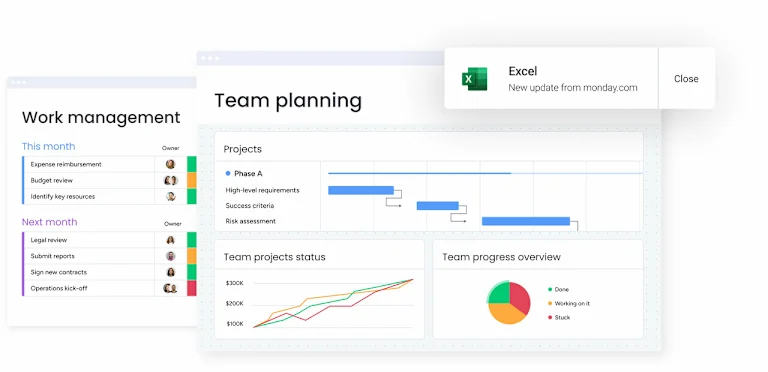Projects rarely fail because of poor technical execution — more often, they falter due to misaligned expectations, unclear communication, or overlooked relationships. That is where stakeholder management becomes essential. By understanding who influences a project and how to engage them effectively, teams can prevent resistance before it starts and turn collaboration into a competitive advantage.
A structured approach to stakeholder management helps translate complex networks of interests into clear priorities and actions. It ensures that communication remains consistent, feedback is captured constructively, and every participant feels invested in shared outcomes.
Throughout this article, we examine the key steps, examples, and templates that bring structure to stakeholder management — showing how to build trust, strengthen accountability, and keep projects on track from kickoff to completion.
Key takeaways
- Strategic importance: stakeholder management directly influences project outcomes and ROI by strengthening relationships that accelerate delivery, reduce delays, and unlock resources.
- Structured process: follow the five-step framework to turn scattered interactions into strategic engagement — identify, analyze, plan, execute, and measure.
- Prioritization tools: use power–interest grids to focus on high-power, high-interest stakeholders while keeping others informed through the right channels.
- Centralized management: work management platforms like monday work management consolidate stakeholder data and automate communication through custom boards and workflows.
- Tailored communication: adapt your message to each group — executives need strategic insights, teams need operational details, and partners need clarity on impacts.
What is stakeholder management?
Stakeholder management is the process of identifying, analyzing, and engaging with people who can impact your work or whose work you impact.
In simple terms, this essentially means building relationships with everyone from team members and executives to customers and suppliers — anyone whose support you need or whose interests you affect.
The goal is to build trust — as research reveals that trustworthy companies outperform their peers in market value by up to four times.
Who is a stakeholder?
A stakeholder is any individual or group that can influence — or be influenced by — your organization’s actions, decisions, or outcomes. This includes internal participants such as employees and executives, as well as external parties like investors, customers, partners, regulators, and community groups. Understanding who your stakeholders are is the first step toward managing relationships that drive project success.
Stakeholder vs shareholder management: differences explained
Shareholders own company stock and focus on financial returns. On the other hand, stakeholders include everyone affected by your business decisions — employees, customers, suppliers, communities, and shareholders too, as explained by stakeholder theory.
Here’s what sets them apart:
- Shareholders: care about stock performance and dividends.
- Stakeholders: care about how your decisions affect their work, lives, or goals.
- Management approach: shareholder management is narrow; stakeholder management is comprehensive.
Core elements of stakeholder management
Effective stakeholder management is built on four connected pillars: identifying stakeholders, analyzing their influence, engaging them strategically, and monitoring results over time. Work management platforms like monday work management help link these steps together — centralizing data, streamlining communication, and ensuring updates stay visible to everyone involved.

How stakeholder management drives business success
Strong stakeholder relationships accelerate project delivery and reduce costly delays. When you manage these relationships proactively, you unlock resources, avoid roadblocks, and make faster decisions.
Key benefits of managing stakeholders
Strategic stakeholder management creates advantages that compound over time:
- Risk mitigation: spot resistance early and address concerns before they derail projects.
- Resource optimization: secure support and expertise exactly when you need it.
- Decision quality: tap into diverse perspectives that improve outcomes.
- Project success rates: meet deadlines through aligned expectations.
- Reputation management: build trust that opens doors for future opportunities.
The value of proactive stakeholder engagement
Poor stakeholder relationships create expensive problems, but a strong risk management plan can mitigate these financial and reputational risks.
Keep in mind that projects tend to stall when key approvers withdraw support and resources disappear when partners feel ignored: this can cause reputation damage that closes future opportunities.
Stakeholder impact on ROI
Engaged stakeholders accelerate returns, and a stakeholders engagement assessment matrix can help measure their level of support. This support translates directly into shorter project cycles and reduced rework costs.
Types of stakeholders in your organization
Different stakeholders bring different concerns, influence levels, and engagement needs. Understanding these distinctions helps you invest time where it matters most.
Internal stakeholders
Internal project stakeholders work within your organization and directly influence daily operations. Each group brings specific priorities:
- Executives: want strategic alignment and measurable business outcomes.
- Team members: need reasonable workloads and growth opportunities.
- Other departments: seek smooth collaboration and fair resource allocation.
- Project sponsors: expect on-time, on-budget delivery.
Work management platforms like monday work management support these needs by centralizing communication, automating updates, and customizing visibility through role-based permissions — ensuring each group stays informed and aligned.
External stakeholders
External stakeholders operate outside your organization but significantly impact your success:
- Customers: demand quality products and reliable service.
- Suppliers: want fair contracts and stable partnerships.
- Regulators: require compliance and transparent reporting. This relationship is critical, as research shows that on average, how a company engages with regulators influences almost a third of its corporate earnings.
- Communities: care about your social and environmental impact.
Managing these relationships requires different strategies since you have less direct control over their priorities.
Primary vs secondary stakeholders
Primary stakeholders directly control critical decisions or resources — like project sponsors or key customers. They need regular communication and proactive issue resolution.
Secondary stakeholders have indirect influence — like industry associations or media contacts. They benefit from periodic updates through broader channels.

The 5-step stakeholder management process
Effective stakeholder management depends on structure and consistency. Rather than relying on ad-hoc communication, a defined process helps teams build lasting trust and alignment.
The following five steps outline how to identify, engage, and manage stakeholders strategically throughout your project lifecycle.
Step 1: identify your stakeholders
Look beyond obvious participants. Brainstorm with your team, review org charts, and examine past projects to uncover everyone who influences or is affected by your work.
Remember that stakeholder lists evolve, while new relationships emerge and priorities may shift throughout your project lifecycle.
Step 2: analyze stakeholder power and interest
Assess each stakeholder’s ability to influence your project and their level of interest in outcomes. Consider formal authority, resource control, expertise, and network connections.
This analysis creates the foundation for targeted engagement strategies that maximize impact.
Step 3: create engagement strategies
Different stakeholders need different approaches, so crafting a stakeholders engagement strategy is essential. High-power, high-interest stakeholders require frequent, detailed communication. Lower-influence groups might prefer periodic updates.
Consider communication preferences, decision-making styles, and optimal meeting frequencies when designing your approach.
Step 4: execute your stakeholder plan
Consistency builds trust. Establish regular touchpoints, document interactions, and follow through on commitments to navigate project complexities smoothly.
It’s also important to utilize platforms like Monday work management that can automate routine communications while tracking relationship history.
Step 5: track and optimize results
Monitor engagement effectiveness through response rates, feedback quality, and relationship satisfaction. Use these insights to adjust strategies and improve outcomes over time, guided by a change management process when stakeholder needs evolve.
How to map and prioritize stakeholders
A stakeholder map turns complex relationships into clear visual insights, showing who holds influence, how interests align, and where attention is most needed. Mapping stakeholders helps prioritize communication, allocate resources effectively, and anticipate shifting dynamics as projects evolve.
Below, we show you how to map and prioritize stakeholders using proven techniques:
Stakeholder mapping techniques
Multiple approaches help you understand different relationship dimensions:
- Power-interest grids: plot influence against interest levels.
- Influence networks: map connections between stakeholders.
- Journey mapping: track relationship evolution over time.
- Quality assessments: evaluate current relationship strength.
Choose techniques based on your project complexity and available time.
Building your stakeholder matrix
Create a comprehensive matrix including names, roles, influence levels, interests, and engagement preferences. Add columns for recent interactions and upcoming needs.
Platforms such as monday work management make this process easier by offering customizable boards so you can build and maintain your matrix.
Using the power-interest grid
The power-interest grid guides engagement priorities:
- High power, high interest: manage closely with regular updates.
- High power, low interest: keep satisfied with executive summaries.
- Low power, high interest: keep informed through detailed communications.
- Low power, low interest: monitor with minimal contact.
Remember stakeholders move between quadrants as circumstances change.

Stakeholder analysis methods that deliver results
Deep analysis uncovers motivations and concerns that drive stakeholder behavior. This understanding enables more effective engagement.
The stakeholder analysis framework
Ask key questions about each stakeholder to guide your stakeholder analysis: What outcomes matter most to them? What constraints shape their decisions? How do they measure success?
Document insights in profiles your team can reference when planning communications or making decisions.
Measuring influence and impact
Evaluate multiple influence sources — formal authority, resource control, expertise, and informal networks. Then assess how their support or opposition could affect your outcomes.
Prioritization strategies that work
Beyond power-interest analysis, consider:
- Urgency: Who needs immediate attention?
- Relationship quality: Where could improvements unlock value?
- Strategic importance: Who aligns with long-term goals?
Building your stakeholder management plan
Strong analysis goes beyond listing names – it uncovers what motivates each stakeholder and how their influence shapes project outcomes. Understanding these dynamics helps teams communicate with purpose, anticipate resistance, and build lasting support.
Let’s explore some practical methods to turn stakeholder insight into strategic action.
Must-have plan components
Essential elements for comprehensive stakeholder management include:
- Stakeholder register: complete contact and relationship details.
- Engagement strategies: tailored approaches for each group.
- Communication schedule: timing for updates and meetings.
- Success metrics: indicators of relationship health.
- Risk mitigation: plans for potential challenges.
Communication rhythm and channels
Match frequency to stakeholder needs. High-influence stakeholders need frequent direct contact. Broader groups prefer periodic updates.
Select channels based on message complexity and stakeholder preferences — face-to-face for sensitive topics, dashboards for routine updates.
Stakeholder roles and RACI matrix
RACI (Responsible, Accountable, Consulted, Informed) clarifies involvement levels and prevents confusion. Document who owns decisions, who provides input, and who receives updates.

Best stakeholder communication strategies to follow
Clear, intentional communication is the foundation of strong stakeholder relationships. When messages are structured and consistent, they build trust, reduce friction, and keep projects moving forward.
The following strategies outline how to select the right channels and tailor your messaging to each audience.
Selecting effective communication channels
Match channels to message characteristics and stakeholder preferences. Complex topics need detailed presentations. Routine updates work through automated dashboards.
Monday work management integrates multiple channels while maintaining centralized records.
Crafting messages for different audiences
Tailor content to stakeholder perspectives:
- Executives: focus on business impact and strategic implications.
- Teams: provide operational details and timelines.
- Partners: explain how changes affect their interests.
Managing expectations proactively
Address changes transparently with context and action plans. Set realistic expectations early and update them promptly when circumstances shift.
Stakeholder management examples across industries
Stakeholder management looks different in every context, but the core principles remain the same — clear communication, structured engagement, and consistent alignment.
The following examples show how these practices work in action across technology, organizational change, and product development initiatives.
Technology project launch
A software implementation coordinates IT teams, end users, executives, and vendors. Each brings different concerns — technical compatibility, training needs, ROI expectations, and delivery requirements.
The engagement strategy includes technical reviews, user training, executive dashboards, and vendor protocols. Monday work management provides role-based access and automated updates for each group.
Organizational transformation
Restructuring impacts employees, managers, customers, and investors — often creating competing priorities and uncertainty. Managing this change effectively depends on clear communication, consistent support, and visible leadership.
Key strategies include:
- Transparent communication: share the reasons for change, expected outcomes, and timelines.
- Employee support: provide guidance, resources, and empathy during transitions.
- Stakeholder reassurance: maintain confidence through updates on continuity and performance.
- Ongoing feedback: use town halls, surveys, and progress reports to track sentiment and address concerns.
New product development
R&D, marketing, sales, and external partners each shape product decisions. Cross-functional meetings, customer sessions, and supplier workshops ensure all perspectives inform development while maintaining alignment.

Ready-to-use stakeholder management templates
Well-designed templates turn stakeholder management from a complex process into an organized, repeatable system. They offer structure for tracking relationships, coordinating communication, and maintaining alignment across teams.
Check out the following templates that can be customized to fit your project’s scale and stakeholder needs:
Stakeholder register template
Track contact information, roles, influence levels, interests, communication preferences, engagement history, and upcoming requirements in one organized location.
Communication planning template
Structure your outreach with stakeholder details, message types, frequencies, channels, responsible parties, and success metrics.
Stakeholder analysis matrix template
Systematically evaluate identification details, influence dimensions, interest levels, engagement strategies, risks, and improvement opportunities.
Stakeholder management best practices
These proven project management strategies maximize engagement effectiveness across industries and project types:
1. Build trust through transparency
Share information proactively, including challenges. Transparency prevents surprises and demonstrates respect for stakeholder interests, a critical practice in large enterprises where research shows there is a significant opportunity to improve transparency, as less than two thirds of employees report satisfaction in this area.
2. Maintain regular touchpoints
Consistent communication keeps relationships strong, even during quiet periods. Brief check-ins often uncover valuable insights.
3. Measure engagement success
Track both quantitative metrics (response rates, attendance) and qualitative indicators (feedback quality, support willingness) to guide improvements.
4. Document everything
Comprehensive records support accountability and smooth transitions. Maintain meeting notes, decisions, and commitment tracking in accessible systems.
5. Stay agile and adaptive
Monitor changing priorities and adjust strategies accordingly. Flexibility demonstrates responsiveness and maintains relationship relevance.

Transform stakeholder management with monday work management
As organizations scale, managing stakeholders manually becomes time-consuming and fragmented. Spreadsheets lead to silos, email threads disappear, and key relationships lose momentum.
Work management platforms like monday work management bring every stakeholder interaction into one connected system. They centralize information, automate communications, and provide real-time visibility into relationship health — ensuring nothing slips through the cracks. From custom boards and automated workflows to dashboards and templates, monday work management helps teams manage stakeholder engagement efficiently and at scale.
Advanced automations that save hours
Eliminate repetitive stakeholder management tasks with powerful automations that work while you sleep. Set up triggers that handle routine communications and updates automatically:
- Auto-notify stakeholders when project status changes.
- Schedule recurring status updates based on stakeholder preference.
- Trigger approval requests when milestones are reached.
200+ integrations for seamless workflows
Connect your stakeholder management system with the tools your team already uses. Maintain a single source of truth while leveraging specialized platforms:
- Sync contact information with CRM systems.
- Import meeting notes directly from collaboration tools.
- Connect feedback forms to stakeholder profiles.
Powerful AI features that enhance engagement
Leverage AI to generate insights and optimize your stakeholder communications. Turn data into actionable intelligence that strengthens relationships:
- Generate personalized communication templates based on stakeholder profiles.
- Identify engagement patterns to predict stakeholder needs.
- Receive suggestions for optimal meeting timing and frequency.
Stakeholder visibility that builds trust
Create transparency that strengthens relationships through customizable dashboards and reporting. Give stakeholders exactly what they need to stay informed and confident:
- Role-based dashboards that show relevant information to each stakeholder.
- Real-time progress tracking that eliminates surprises.
- Historical data access that provides complete context.
The platform turns stakeholder management from a manual burden into a strategic advantage that scales with your organization. Get started with monday work management today.
Frequently asked questions
What specific skills help with stakeholder management in complex projects?
Strong stakeholder management in complex projects relies on a mix of interpersonal and strategic skills. Active listening helps uncover diverse perspectives, while adaptive communication ensures messages resonate with different audiences. Emotional intelligence supports empathy and trust, especially in high-pressure situations. You also need negotiation skills to align competing interests and systems thinking to manage multiple relationships and priorities at once.
How do you handle conflicting stakeholder interests in project decisions?
Managing conflicting interests requires transparent communication about constraints and trade-offs while actively seeking solutions that address multiple concerns. Focus discussions on shared project goals and use collaborative problem-solving sessions where stakeholders work together to find acceptable compromises.
When should you update your stakeholder management plan during a project?
Update your plan whenever project scope expands or contracts significantly, new stakeholders join or existing ones leave, or when stakeholder influence or interest levels shift noticeably. Schedule quarterly reviews as a baseline, with additional updates triggered by major project changes.
What are the most common stakeholder management mistakes in enterprise settings?
To avoid common pitfalls in enterprise settings, it's important to identify all stakeholders beyond the obvious ones, use tailored messages for different groups, and maintain relationships consistently, even during project lulls. This lack of clear, tailored communication can have serious consequences; for example, research shows that in the largest enterprises, only 43% of employees understand how their individual success is measured.
How does stakeholder management differ from general relationship management?
Stakeholder management focuses on specific project or business outcomes with systematic identification and engagement of people who impact your work. General relationship management builds broader professional networks without necessarily tying connections to immediate business objectives or structured engagement plans.
Why do stakeholder management initiatives fail in fast-growing companies?
Initiatives fail when companies treat stakeholder management as a checkbox exercise rather than embedding it into workflows, or when they focus exclusively on high-profile stakeholders while neglecting operational relationships. Fast growth amplifies these issues as new stakeholders emerge rapidly and existing relationships require different engagement approaches.
 Get started
Get started 

